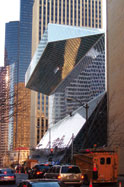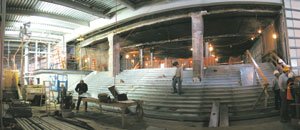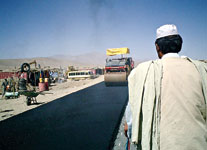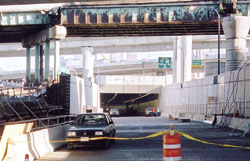|
|
 |
| Maine bridge was fixed with stronger cables. (Photo courtesy of Cianbro) |
 Lisbons Tagus River Bridge, arsons Transportation Groups Jamey A. Barbas was uniquely qualified to lead the emergency supplemental cable installation on the 72-year-old, 1,500-ft-long Waldo-Hancock Bridge in Maine. State officials wanted a quick and cost-effective fix after discovering extensive degradation on one main cable, which forced load limitations and a fast-track replacement. Barbas work restored the bridge to original load-carrying capacity and proved cable strengthening is an economical alternative to replacement.
Lisbons Tagus River Bridge, arsons Transportation Groups Jamey A. Barbas was uniquely qualified to lead the emergency supplemental cable installation on the 72-year-old, 1,500-ft-long Waldo-Hancock Bridge in Maine. State officials wanted a quick and cost-effective fix after discovering extensive degradation on one main cable, which forced load limitations and a fast-track replacement. Barbas work restored the bridge to original load-carrying capacity and proved cable strengthening is an economical alternative to replacement.

![]() Keeping a 100-year-old, 660-mile subway network well-maintained and working at capacity is a daunting challenge, but Mysore Nagaraja has exceeded expectations in New York City. As former senior vice president and chief engineer of the Metropolitan Transportation Authoritys New York City Transit unit, he supervised more than $4 billion in line, facility and station renovations. These include the fast-track restoration of the subway line in lower Manhattan that was heavily damaged on Sept. 11, 2001. Nagaraja has set a new tone for MTA construction, slicing through bureaucracy and keeping bid prices realistic and competitive. He now is president of MTAs newly formed Capital Construction Co.
Keeping a 100-year-old, 660-mile subway network well-maintained and working at capacity is a daunting challenge, but Mysore Nagaraja has exceeded expectations in New York City. As former senior vice president and chief engineer of the Metropolitan Transportation Authoritys New York City Transit unit, he supervised more than $4 billion in line, facility and station renovations. These include the fast-track restoration of the subway line in lower Manhattan that was heavily damaged on Sept. 11, 2001. Nagaraja has set a new tone for MTA construction, slicing through bureaucracy and keeping bid prices realistic and competitive. He now is president of MTAs newly formed Capital Construction Co.
 |
| Other U.S. cities are looking at Seattles template that produced an architectural icon while reinventing libraries. (Photo courtesy of Michael Dickter Magnusson Klemencic Associates) |

![]() Seattle City Librarian Deborah L. Jacobs shatters stereotypes about librarians the way the 412,000-sq-ft Seattle Central Library shatters stereotypes about libraries. In the gravity-defying flagship of the citys $235-million Libraries for All capital program, Jacobs and her team have harnessed innovative architecture, engineering and construction to reinvent and reinvigorate the venerated institution. Jacobs engaged citizens and inspired designers to devise a new programmatic model that successfully commingles the "book" age with the digital age. The crusade has produced a civic architectural icon that provides an inspirational environment for people to meet, think and borrow, free of charge.
Seattle City Librarian Deborah L. Jacobs shatters stereotypes about librarians the way the 412,000-sq-ft Seattle Central Library shatters stereotypes about libraries. In the gravity-defying flagship of the citys $235-million Libraries for All capital program, Jacobs and her team have harnessed innovative architecture, engineering and construction to reinvent and reinvigorate the venerated institution. Jacobs engaged citizens and inspired designers to devise a new programmatic model that successfully commingles the "book" age with the digital age. The crusade has produced a civic architectural icon that provides an inspirational environment for people to meet, think and borrow, free of charge.

![]() As chief engineer to the general commanding the Fifth U.S. Army Corps in Iraq, Col. Gregg Martin was resource planner, scheduler and project manager for combat engineers in last springs campaign. The fast-moving assaults demand for hard-charging combat construction resources redefined the role of the modern warrior-engineer. As fighting ebbed, Martins troops rapidly became the first to respond to the challenges of reconstruction and were critical sustainers of the peacemaking effort. Martin led his troops in setting an exemplary and courageous standard for the accomplishment of a host of construction missions.
As chief engineer to the general commanding the Fifth U.S. Army Corps in Iraq, Col. Gregg Martin was resource planner, scheduler and project manager for combat engineers in last springs campaign. The fast-moving assaults demand for hard-charging combat construction resources redefined the role of the modern warrior-engineer. As fighting ebbed, Martins troops rapidly became the first to respond to the challenges of reconstruction and were critical sustainers of the peacemaking effort. Martin led his troops in setting an exemplary and courageous standard for the accomplishment of a host of construction missions.

![]() Its a very simple idea with very far-ranging implications and the engineering director of the San Juan Unified School District outside Sacramento is the first to carry it out. San Juan has about 400 of what are believed to be California's 80,000 portable classroom units. Many are in bad shape with air, lighting and acoustics below state standards. Engineering director Don Haase decided the district could create permanent classrooms cheaply by keeping steel frames of many of the portable classrooms and fitting them with new walls, roofs and interiors. Thousands of dollars are saved with each unit and other districts have noticed.
Its a very simple idea with very far-ranging implications and the engineering director of the San Juan Unified School District outside Sacramento is the first to carry it out. San Juan has about 400 of what are believed to be California's 80,000 portable classroom units. Many are in bad shape with air, lighting and acoustics below state standards. Engineering director Don Haase decided the district could create permanent classrooms cheaply by keeping steel frames of many of the portable classrooms and fitting them with new walls, roofs and interiors. Thousands of dollars are saved with each unit and other districts have noticed.

![]() Engineer Ahmad Rahimians seismic design for Latin Americas tallest building proved, several months before Torre Mayor officially opened, that Mexico City could shake without the 225-meter-tall tower being damaged. Frayed nerves are calmed by a novel configuration of 24 dampers in a perimeter braced frame coupled with a perimeter moment frame, and 72 dampers in the core. Placement of perimeter dampers between bracing lines optimizes response to quake forces and increases creature comfort, a concept so novel that Cantor-Seinuks Rahimian patented the design. The $4 million spent for dampers nearly paid for itself by reducing steel tonnage and caisson depth, each by more than 20%. The system allowed tighter mechanical tolerances and will minimize quake damage to finishes.
Engineer Ahmad Rahimians seismic design for Latin Americas tallest building proved, several months before Torre Mayor officially opened, that Mexico City could shake without the 225-meter-tall tower being damaged. Frayed nerves are calmed by a novel configuration of 24 dampers in a perimeter braced frame coupled with a perimeter moment frame, and 72 dampers in the core. Placement of perimeter dampers between bracing lines optimizes response to quake forces and increases creature comfort, a concept so novel that Cantor-Seinuks Rahimian patented the design. The $4 million spent for dampers nearly paid for itself by reducing steel tonnage and caisson depth, each by more than 20%. The system allowed tighter mechanical tolerances and will minimize quake damage to finishes.

![]() Heralding a sea change in data collection, Mark Klusza, co-founder and president of BitWyse Solutions Inc., developed LASERGen software that quickly integrates raw laser scan data into CAD-ready computer files. The system analyzes and displays raw data within CAD files, eliminating cumbersome manual tracing or remodeled laser scans while providing clash protection. Laser scanning is poised to replace manual measurements, photogrammetry and videogrammetry as a fast, cost-effective means of collecting and utilizing data. LASERGen provides a fast, low cost platform to help speed this change.
Heralding a sea change in data collection, Mark Klusza, co-founder and president of BitWyse Solutions Inc., developed LASERGen software that quickly integrates raw laser scan data into CAD-ready computer files. The system analyzes and displays raw data within CAD files, eliminating cumbersome manual tracing or remodeled laser scans while providing clash protection. Laser scanning is poised to replace manual measurements, photogrammetry and videogrammetry as a fast, cost-effective means of collecting and utilizing data. LASERGen provides a fast, low cost platform to help speed this change.

![]() The first union of steel pipe megacolumns filled with concrete and steel-plate shear walls, which form the core of Seattles 118-meter-tall federal courthouse, offers the pluses of pure concrete shear wall cores without penalties of mass and weight. The hybrid system, developed by structural engineer Kurt A. Nordquist before he retired from Magnusson Klemencic Associates, protects the courthouse with superior earthquake resistance. It also frees exterior walls of heavy structure, allowing for transparent architecture while gobbling up less real estate than would a concrete core. Under seismic loads, megacolumns that provide boundary elements for the core walls remain pristine while the walls are allowed to deform.
The first union of steel pipe megacolumns filled with concrete and steel-plate shear walls, which form the core of Seattles 118-meter-tall federal courthouse, offers the pluses of pure concrete shear wall cores without penalties of mass and weight. The hybrid system, developed by structural engineer Kurt A. Nordquist before he retired from Magnusson Klemencic Associates, protects the courthouse with superior earthquake resistance. It also frees exterior walls of heavy structure, allowing for transparent architecture while gobbling up less real estate than would a concrete core. Under seismic loads, megacolumns that provide boundary elements for the core walls remain pristine while the walls are allowed to deform.

![]() The U.S. Green Building Councils Leadership in Energy and Environmental Design rating system has become the standard tool for evaluating environmental impact of commercial and institutional construction. As chair of the councils LEED steering committee, Rob Watson, a senior scientist at the Natural Resources Defense Council, helped create the systems framework and was instrumental in obtaining key startup funding. Since launch of the performance-based metric in 2000, owners and building teams for more than 1,000 projects, or about 5% of U.S. commercial construction, have taken the first step toward achieving a LEED rating. Several federal agencies have adopted LEED and many municipal governments mandate a minimum LEED rating as a prerequisite for public funding. Watson is championing adoption of LEED in China where it is already being used for design and construction of several projects.
The U.S. Green Building Councils Leadership in Energy and Environmental Design rating system has become the standard tool for evaluating environmental impact of commercial and institutional construction. As chair of the councils LEED steering committee, Rob Watson, a senior scientist at the Natural Resources Defense Council, helped create the systems framework and was instrumental in obtaining key startup funding. Since launch of the performance-based metric in 2000, owners and building teams for more than 1,000 projects, or about 5% of U.S. commercial construction, have taken the first step toward achieving a LEED rating. Several federal agencies have adopted LEED and many municipal governments mandate a minimum LEED rating as a prerequisite for public funding. Watson is championing adoption of LEED in China where it is already being used for design and construction of several projects.

![]() Not only will Taipei 101, the 508-meter-tall tower in Taiwans capital, acquire the record of worlds tallest when it opens this year, it also boasts the worlds largest tuned mass damper. The 660-tonne spherical TMD, designed by a team led by Motioneering Inc.s Brian Breukelman, will be visible from upper level public areas as part of the buildings architecture. The element joins a trend to use damping to counter increasing vibrations caused by ever-taller towers that are less stiff.
Not only will Taipei 101, the 508-meter-tall tower in Taiwans capital, acquire the record of worlds tallest when it opens this year, it also boasts the worlds largest tuned mass damper. The 660-tonne spherical TMD, designed by a team led by Motioneering Inc.s Brian Breukelman, will be visible from upper level public areas as part of the buildings architecture. The element joins a trend to use damping to counter increasing vibrations caused by ever-taller towers that are less stiff.

![]() In a move intended to raise quality, the Council of American Structural Engineers has published A Guideline Addressing Coordination and Completeness of Structural Construction Documents. Degenkolb Engineers Thomas D. Wosser led the two-year effort that produced the 35-page "coping mechanism" intended to help structural engineers get away from the extremes of being the beat-up kid or the belligerent bully. The primer defines and discusses nearly everything an engineer needs to know on the business of a project, including design team responsibilities, delivery systems and quality management. CASE produced the guide even though, as a de facto standard of care, lawyers for contractors might use it against engineers on claims.
In a move intended to raise quality, the Council of American Structural Engineers has published A Guideline Addressing Coordination and Completeness of Structural Construction Documents. Degenkolb Engineers Thomas D. Wosser led the two-year effort that produced the 35-page "coping mechanism" intended to help structural engineers get away from the extremes of being the beat-up kid or the belligerent bully. The primer defines and discusses nearly everything an engineer needs to know on the business of a project, including design team responsibilities, delivery systems and quality management. CASE produced the guide even though, as a de facto standard of care, lawyers for contractors might use it against engineers on claims.
 |
| Restoring PATH commuter service between New York City and New Jersey was a four-year job that took just 21 months. (Photo courtesy of Port Authority of New York and New Jersey) |

![]() Tom Groark, assistant chief engineer of the Port Authority of New York and New Jersey, ably managed a team of agency professionals and outside contractors that restored complete service to the Port Authority Trans-Hudson rail system, damaged on Sept. 11, 2001, in just 21 months. The $566-million project included reconstruction of damaged and flooded tunnels, stations and related infrastructure. It was complicated by federal funding oversight and scheduling unknowns dictated by Ground Zero cleanup.
Tom Groark, assistant chief engineer of the Port Authority of New York and New Jersey, ably managed a team of agency professionals and outside contractors that restored complete service to the Port Authority Trans-Hudson rail system, damaged on Sept. 11, 2001, in just 21 months. The $566-million project included reconstruction of damaged and flooded tunnels, stations and related infrastructure. It was complicated by federal funding oversight and scheduling unknowns dictated by Ground Zero cleanup.

![]() Architect James Timberlake convinced skeptical maintenance and facilities officials at the University of Pennsylvania to use a unitized, pressurized, double-skin curtain wall to clad the $15.5-million building that KieranTimberlake Associates was designing for the School of Engineering and Applied Science. Although the system was untried in the U.S., Timberlake persuaded the owner on the systems merits even after the general contractor offered to close an 8% budget gap by substituting a conventional stick-built, single-skin system. Return room air circulates in a 4-in. cavity between the walls outer and inner face, permitting downsizing of the mechanical system. The curtain wall also uses a highly transparent glass to maximize penetration of natural light into the 48,000-sq-ft, six-story building, and still comply with a tough city energy code.
Architect James Timberlake convinced skeptical maintenance and facilities officials at the University of Pennsylvania to use a unitized, pressurized, double-skin curtain wall to clad the $15.5-million building that KieranTimberlake Associates was designing for the School of Engineering and Applied Science. Although the system was untried in the U.S., Timberlake persuaded the owner on the systems merits even after the general contractor offered to close an 8% budget gap by substituting a conventional stick-built, single-skin system. Return room air circulates in a 4-in. cavity between the walls outer and inner face, permitting downsizing of the mechanical system. The curtain wall also uses a highly transparent glass to maximize penetration of natural light into the 48,000-sq-ft, six-story building, and still comply with a tough city energy code.
 |
| Afghan road project may be worlds most dangerous. (Photo courtesy of the Berger Group) |

![]() Construction professionals are serving literally on the front lines of the war on terror and Fred Chace, Louis Berger Group superintendent on the Kabul-to-Kandahar highway project in Afghanistan, exemplifies the spirit of these dedicated people. In an Oct. 13 ambush on a remote stretch of road, a bullet creased the top of his head, causing severe bleeding. He was evacuated and treated in Kandahar, but returned to work five days later. He declined a job as contracts manager in Kabul, saying he felt he could contribute most by working in the field.
Construction professionals are serving literally on the front lines of the war on terror and Fred Chace, Louis Berger Group superintendent on the Kabul-to-Kandahar highway project in Afghanistan, exemplifies the spirit of these dedicated people. In an Oct. 13 ambush on a remote stretch of road, a bullet creased the top of his head, causing severe bleeding. He was evacuated and treated in Kandahar, but returned to work five days later. He declined a job as contracts manager in Kabul, saying he felt he could contribute most by working in the field.

![]() Thornton-Tomasetti structural engineer Joseph G. Burns dragged the team building Chicagos 61,500-seat Soldier Field into the digital age of steel design and detailing. The move sounded a faint but audible death knell for the traditional paper drawing as a contract deliverable. Burns knew that creating an accurate three-dimensional, digital model and sharing it with the steel fabricator was the best way to ensure an accurate field fit-up of the 13,000-ton primary frame, critical for timely completion. The process, still in its shake-out phase, eliminates the fabricators redrawing of design documents and the errors that can follow. It also speeds approvals.
Thornton-Tomasetti structural engineer Joseph G. Burns dragged the team building Chicagos 61,500-seat Soldier Field into the digital age of steel design and detailing. The move sounded a faint but audible death knell for the traditional paper drawing as a contract deliverable. Burns knew that creating an accurate three-dimensional, digital model and sharing it with the steel fabricator was the best way to ensure an accurate field fit-up of the 13,000-ton primary frame, critical for timely completion. The process, still in its shake-out phase, eliminates the fabricators redrawing of design documents and the errors that can follow. It also speeds approvals.

![]() Seeking the best solutions for the Bonneville Power Administrationss 600-mile transmission grid expansion program, network planning manager Brian Silverstein threw open the doors to give a full array of stakeholders a voice in evaluating possible ways to meet the need. He established the Roundtable on Nonconstruction Alternatives, with 18 members representing a wide spectrum of the public. The federal utilitys openness to public scrutiny generated a trust that eliminated objections to current projects and turned attention to evaluating proposed ones.
Seeking the best solutions for the Bonneville Power Administrationss 600-mile transmission grid expansion program, network planning manager Brian Silverstein threw open the doors to give a full array of stakeholders a voice in evaluating possible ways to meet the need. He established the Roundtable on Nonconstruction Alternatives, with 18 members representing a wide spectrum of the public. The federal utilitys openness to public scrutiny generated a trust that eliminated objections to current projects and turned attention to evaluating proposed ones.

![]() For homeland security, engineers responsible for public water supply quality assurance needed quicker test results than the standard 24 to 96-hour turnaround. Kenneth Hayes, president of Aqua Survey Inc., developed a one-hour test kit for water contamination that uses daphnia, or water fleas, to detect a wide range of toxins that could be available to terrorists. Battelle Memorial Institute and the U.S. Environmental Protection Agency confirmed that Aqua Survey kits detected all toxins in product tests.
For homeland security, engineers responsible for public water supply quality assurance needed quicker test results than the standard 24 to 96-hour turnaround. Kenneth Hayes, president of Aqua Survey Inc., developed a one-hour test kit for water contamination that uses daphnia, or water fleas, to detect a wide range of toxins that could be available to terrorists. Battelle Memorial Institute and the U.S. Environmental Protection Agency confirmed that Aqua Survey kits detected all toxins in product tests.
![]() When a general contractor in Westlake, La., was looking for a faster and safer way to lay reinforced concrete pipe, its solution was the "Pipe Caddy," a unique lifting attachment for hydraulic excavators that eliminates dangerous rigging. Gavin Abshire, Pipe Caddy co-inventor and president of River West Enterprises, claims it enables operators to pick, carry and place twice as much pipe per shift without leaving the cab. Contractors using the attachment say they have "made a fortune" by cutting installation time while enhancing jobsite safety.
When a general contractor in Westlake, La., was looking for a faster and safer way to lay reinforced concrete pipe, its solution was the "Pipe Caddy," a unique lifting attachment for hydraulic excavators that eliminates dangerous rigging. Gavin Abshire, Pipe Caddy co-inventor and president of River West Enterprises, claims it enables operators to pick, carry and place twice as much pipe per shift without leaving the cab. Contractors using the attachment say they have "made a fortune" by cutting installation time while enhancing jobsite safety.
 In 1997, the Minnesota Dept. of Transportation demanded that contractors find a unified way to train construction-truck drivers or it would do it for them. Larry Ouellette of St. Cloud State University has brought together public and private partners for the states new training program. As its chief administrator and instructor, Ouellette has helped contractors, state transportation officials and state police tackle work-zone safety with quantifiable results in reduced accidents and insurance premiums. In 2004, contractors will send about 2,000 operators to the program, the most in its five-year history.
In 1997, the Minnesota Dept. of Transportation demanded that contractors find a unified way to train construction-truck drivers or it would do it for them. Larry Ouellette of St. Cloud State University has brought together public and private partners for the states new training program. As its chief administrator and instructor, Ouellette has helped contractors, state transportation officials and state police tackle work-zone safety with quantifiable results in reduced accidents and insurance premiums. In 2004, contractors will send about 2,000 operators to the program, the most in its five-year history.
 |
| Boston's CA/T project opened a critical link in 2003. (Photo courtesy of Matt Poirier / Bigdig.com) |

![]() Using a challenging variety of engineering techniques Michael T. Bertoulin, the Central Artery/Tunnel Projects Interstate 90 milestone manager and Parsons Brinckerhoff Quade & Douglas vice president, overcame chronic schedule problems to open the critical section of the $6.5-billion I-90 tunnel connecting the Massachusetts Turnpike with Logan International Airport. Bertoulin oversaw construction of a vast array of jacked, immersed and cut-and-cover tunnels through the largest soil mixing operation in North America. He modified plans and simultaneously ran dredging, drilled shaft, casting basin and cut-and-cover changes that compressed two years worth of work into one.
Using a challenging variety of engineering techniques Michael T. Bertoulin, the Central Artery/Tunnel Projects Interstate 90 milestone manager and Parsons Brinckerhoff Quade & Douglas vice president, overcame chronic schedule problems to open the critical section of the $6.5-billion I-90 tunnel connecting the Massachusetts Turnpike with Logan International Airport. Bertoulin oversaw construction of a vast array of jacked, immersed and cut-and-cover tunnels through the largest soil mixing operation in North America. He modified plans and simultaneously ran dredging, drilled shaft, casting basin and cut-and-cover changes that compressed two years worth of work into one.

![]() From past experience, Tarik Ayyad knows what can happen when builders are not kept abreast of design changes. To find a solution, he developed ShareChive, a service that shares project data hosted on the companys server, with ruggedized tablet PCs that are leased to clients. Tablets are fully loaded with massive amounts of project data and synchronize changes automatically with the main database opportunistically, meaning whenever they enter an area of cell phone service. Similarly, all records made on tablets are stored and shared just as often, ensuring that if one is lost or destroyed, its data has already been captured by the central database and every other tablet PC on the job.
From past experience, Tarik Ayyad knows what can happen when builders are not kept abreast of design changes. To find a solution, he developed ShareChive, a service that shares project data hosted on the companys server, with ruggedized tablet PCs that are leased to clients. Tablets are fully loaded with massive amounts of project data and synchronize changes automatically with the main database opportunistically, meaning whenever they enter an area of cell phone service. Similarly, all records made on tablets are stored and shared just as often, ensuring that if one is lost or destroyed, its data has already been captured by the central database and every other tablet PC on the job.

![]() Designers, contractors and owners can now work together to minimize mold problems in buildings by using a manual that elevates the level of knowledge. Rick Poppe, strategic growth officer at The Weitz Co., led the Associated General Contractors task force that wrote the manual. The group was committed to producing the document despite concern that it may be used as a standard of care in litigation. The important issue, members believed, is that the manual provides the whole construction team with an action-oriented tool to help prevent mold problems in the first place
Designers, contractors and owners can now work together to minimize mold problems in buildings by using a manual that elevates the level of knowledge. Rick Poppe, strategic growth officer at The Weitz Co., led the Associated General Contractors task force that wrote the manual. The group was committed to producing the document despite concern that it may be used as a standard of care in litigation. The important issue, members believed, is that the manual provides the whole construction team with an action-oriented tool to help prevent mold problems in the first place

![]() Overwhelmed by the unprecedented amount of work after voters approved $1.5 billion in funding, San Diegos school construction program got off to a slow start, completing less work for more money than was budgeted. Lou Smith, a retired Navy construction executive, was able to use the same staff plus new hires and consultants and turn the program around. Under his leadership, San Diego city schools have completed millions of dollars of classroom and school renovations that meet the districts educational goals. Smith brought modern management techniques to a mid-size citys school building plan.
Overwhelmed by the unprecedented amount of work after voters approved $1.5 billion in funding, San Diegos school construction program got off to a slow start, completing less work for more money than was budgeted. Lou Smith, a retired Navy construction executive, was able to use the same staff plus new hires and consultants and turn the program around. Under his leadership, San Diego city schools have completed millions of dollars of classroom and school renovations that meet the districts educational goals. Smith brought modern management techniques to a mid-size citys school building plan.

![]() The war in Iraq was still being fought when Bechtel National Inc. was chosen by the U.S. Agency for International Development to head the initial $680-million rebuilding program. Under intense political scrutiny and the need to start the project quickly, Bechtel turned to Cliff Mumm, a veteran program manager with extensive civil infrastructure experience. Under a short deadline to restore power and water and ready the port of Umm Qasr to receive food and supplies, Mumm put together a team of Bechtel leaders, Iraqi subcontractors and an international work force. The port was opened in October and the fast-track program is on schedule despite unrest.
The war in Iraq was still being fought when Bechtel National Inc. was chosen by the U.S. Agency for International Development to head the initial $680-million rebuilding program. Under intense political scrutiny and the need to start the project quickly, Bechtel turned to Cliff Mumm, a veteran program manager with extensive civil infrastructure experience. Under a short deadline to restore power and water and ready the port of Umm Qasr to receive food and supplies, Mumm put together a team of Bechtel leaders, Iraqi subcontractors and an international work force. The port was opened in October and the fast-track program is on schedule despite unrest.



Post a comment to this article
Report Abusive Comment